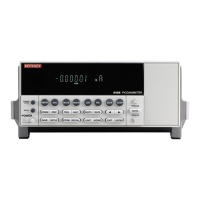C-4 General Measurement Considerations Model 6485 Picoammeter Instruction Manual
Electrochemical effects
Error currents also arise from electrochemical effects when ionic chemicals create weak
batteries on a circuit board. These batteries could generate a few nanoamps of current
between conductors. Ionic contamination may be the result of body oils, salts or solder
flux. The problem is further enhanced by high humidity (moisture) that decreases insula-
tion resistance.
When building test fixtures, select insulators that resist water absorption, and use the fix-
ture in a moderate humidity environment. Also, be sure that all insulators are kept clean
and free of contamination. See “Handling and cleaning test fixtures,” page 2-10 for clean-
ing tips.
Humidity
Excess humidity can reduce insulation resistance on PC boards and in test connection
insulators. Reduction in insulation resistance can, of course, seriously affect high-imped-
ance measurements. Also, humidity (moisture) can combine with contaminants to produce
offset currents caused by electrochemical effects see “Electrochemical effects,” page C-4.
To minimize the effects of moisture, keep humidity to a minimum (ideally <50%), and
keep components and connectors in the test system clean. See “Handling and cleaning test
fixtures,” page 2-10 for cleaning tips.
Light
Some components, such as semiconductor junctions and MOS capacitors on semiconduc-
tor wafers, are excellent light detectors. Consequently, these components must be tested in
a light-free environment. While many test fixtures provide adequate light protection, oth-
ers may allow sufficient light penetration to affect the test results. Areas to check for light
leaks include doors and door hinges, tubing entry points, and connectors or connector pan-
els. With this in mind, the Model 6485 display may be turned off either through the front
panel by pressing the DISP, or over the bus by sending the :DISP:ENAB OFF command.
Electrostatic interference
Electrostatic interference occurs when an electrically charged object is brought near an
uncharged object, thus inducing a charge on the previously uncharged object. Usually,
effects of such electrostatic action are not noticeable because low impedance levels allow
the induced charge to dissipate quickly. However, the high impedance levels of many mea-
surements do not allow these charges to decay rapidly and erroneous or unstable readings
may result. These erroneous or unstable readings may be caused in the following ways:
1. DC electrostatic field can cause undetected errors or noise in the reading.
2. AC electrostatic fields can cause errors by driving the input preamplifier into satu-
ration, or through rectification that produces DC errors.

